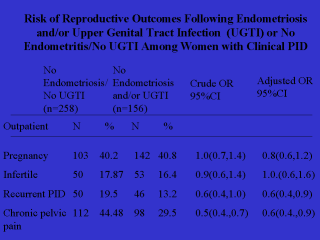 |
Here is some very recent data
that was just submitted for publication, which I think is very provocative. These are
actually data that Kathy Carlson is first author on (and some of the slides at the
beginning of this presentation were hers as well). Thereís only real been one
longitudinal study of PID ever conducted. That study had, in a sense, a real control group
Ė those women who underwent laparoscopy but in fact turned out not to have the clinical
evidence of PID. All of these data about infertility, chronic pelvic pain, and ectopic
pregnancy come from this one longitudinal Scandinavian study. In a sense, the PEACH study
represents the only other prospective study ever done in the area of PID. It may be a big
one but we donít have an obvious control group, except, that all of these women had
endometrial biopsies, which is our surrogate marker for PID because women who have
Salpingitis, the inflammation of the tubes and ovaries, very commonly also have
endometritis. So if we consider endometritis and/or upper genital tract infection, that is
to say if we could literally isolate Gonorrhea or Chlaymidia in the upper genital tract or
endometrium, we can call that the group of women who have real PID, who have something
thatís like Salpingitis, which is about 60% of our population. But we also have, about
40%, of women who actually donít have endometritis or upper genital tract infection. So
letís compare those two and see what we end up with in terms of outcomes.Clearly, a
priori, our expectation was that women who have endometritis and are followed
longitudinally, if we compare them to women who donít, will have higher rates of
infertility, chronic pelvic pain, ectopic pregnancy and so on. What you can see is once
again we donít see a relationship in our data between endometritis and upper genital in
any of these outcomes. We massaged these data trying to find a relation but there is just
nothing there. |
